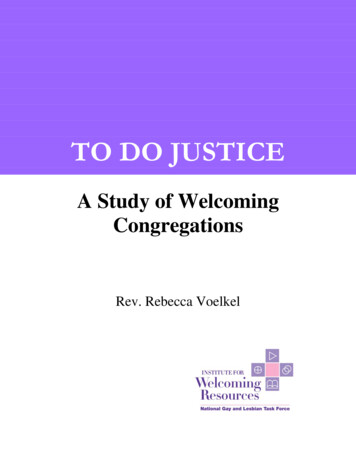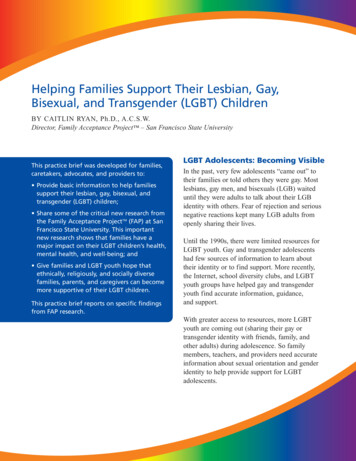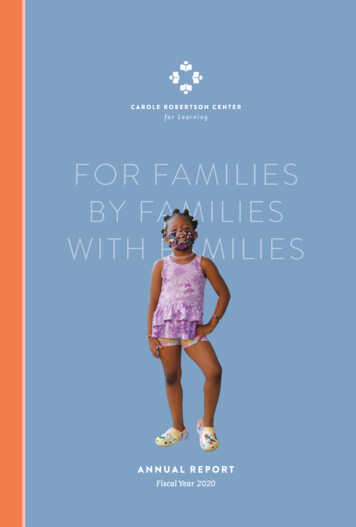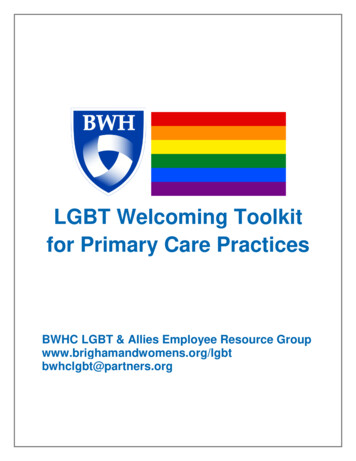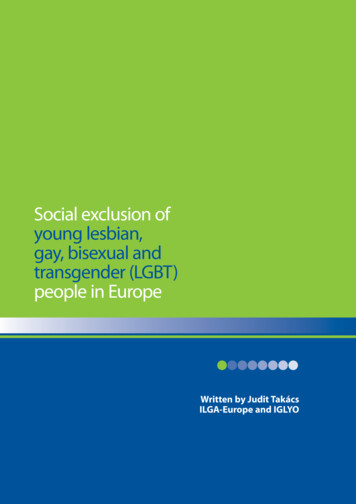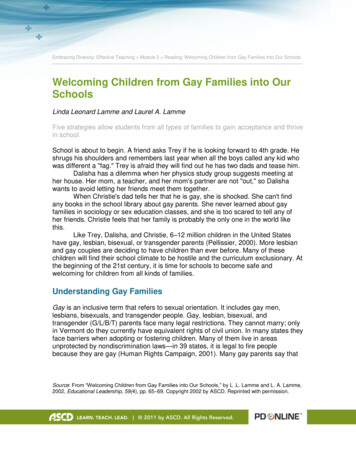
Transcription
Embracing Diversity: Effective Teaching Module 2 Reading: Welcoming Children from Gay Families into Our SchoolsWelcoming Children from Gay Families into OurSchoolsLinda Leonard Lamme and Laurel A. LammeFive strategies allow students from all types of families to gain acceptance and thrivein school.School is about to begin. A friend asks Trey if he is looking forward to 4th grade. Heshrugs his shoulders and remembers last year when all the boys called any kid whowas different a "fag." Trey is afraid they will find out he has two dads and tease him.Dalisha has a dilemma when her physics study group suggests meeting ather house. Her mom, a teacher, and her mom's partner are not "out," so Dalishawants to avoid letting her friends meet them together.When Christie's dad tells her that he is gay, she is shocked. She can't findany books in the school library about gay parents. She never learned about gayfamilies in sociology or sex education classes, and she is too scared to tell any ofher friends. Christie feels that her family is probably the only one in the world likethis.Like Trey, Dalisha, and Christie, 6–12 million children in the United Stateshave gay, lesbian, bisexual, or transgender parents (Pellissier, 2000). More lesbianand gay couples are deciding to have children than ever before. Many of thesechildren will find their school climate to be hostile and the curriculum exclusionary. Atthe beginning of the 21st century, it is time for schools to become safe andwelcoming for children from all kinds of families.Understanding Gay FamiliesGay is an inclusive term that refers to sexual orientation. It includes gay men,lesbians, bisexuals, and transgender people. Gay, lesbian, bisexual, andtransgender (G/L/B/T) parents face many legal restrictions. They cannot marry; onlyin Vermont do they currently have equivalent rights of civil union. In many states theyface barriers when adopting or fostering children. Many of them live in areasunprotected by nondiscrimination laws—in 39 states, it is legal to fire peoplebecause they are gay (Human Rights Campaign, 2001). Many gay parents say thatSource: From ―Welcoming Children from Gay Families into Our Schools,‖ by L .L. Lamme and L. A. Lamme,2002, Educational Leadership, 59(4), pp. 65–69. Copyright 2002 by ASCD. Reprinted with permission.
Embracing Diversity: Effective Teaching Module 2 Reading: Welcoming Children From Gay Families into Our Schoolsthey remain "in the closet" because they fear discrimination toward their child atschool (Bliss & Harris, 1998).There are many different kinds of G/L/B/T families. Many gay families arecloseted; others are "out" or partially out. Parents can be partnered, single, married,divorced, or partnered with another gay couple. Families can be rich or poor,religious or nonreligious, biracial or multicultural. Children enter gay families in manyways: through birth, adoption, surrogate parenting, foster parenting, and artificialinsemination. Research studies conclude that children with lesbian and gay parentscan develop psychologically, intellectually, behaviorally, and emotionally in positivedirections—and that the sexual orientation of parents is not a predictor of successfulchild development (Fitzgerald, 1999). For the most part, family life for children whogrow up in lesbian homes is similar to that experienced by children in heterosexualfamilies (Tasker, 1999).Regardless of their own eventual sexual orientation, these children becomede facto members of the gay community. As such, they likely face a homophobic,heterosexist, and anti-gay society, particularly at school. For example, 84 percent ofstudents in four San Francisco area schools never heard an adult intervene whenhomophobic remarks were made in school (Pellissier, 2000). Likewise, more thanone-third of G/L/B/T students do not feel comfortable talking with school staff aboutG/L/B/T issues (Gay, Lesbian, and Straight Education Network, 2001).If we seek to make our schools truly accept all students, our work is clearlyset out for us.Become InformedOne of the first ways we can improve our school climate is to become informedabout G/L/B/T people and the issues that influence their lives. When reading orlistening to the news, pay attention to gay issues. Learn about gay perspectives ontopics in the media by consulting gay online news sources, newspapers, andmagazines. Become comfortable interacting with gay people: Make friends withsome G/L/B/T individuals and ask them questions. Elicit strategies from gay parentsin your schools for improving your school climate. Visit a gay-affirming church likethe Metropolitan Community Church.The difference between gay families that are "out" and those that are closetedor partially closeted is vital to understand. Children from "out" families may feel likerepresentatives of their community, constantly required to explain their situation anddefend their home life. If a family is even partially "in the closet," the children areoften doubly afraid: They fear that they could be harassed and lose friends if thefamily secret becomes known, and they fear that their parents could bepersecuted—perhaps losing their jobs or home—if they let the secret slip. This fearcan be a paralyzing burden. Besides carefully choosing their words every time theyspeak of their parents, children from closeted families can be afraid to invite friendsover to their house or to form any close friendships.
Embracing Diversity: Effective Teaching Module 2 Reading: Welcoming Children From Gay Families into Our SchoolsCreate a G/L/B/T–Friendly School ClimateThere are many ways for school faculty, administration, and staff to create awelcoming environment for students from gay homes. The first step is to providediversity training for all school personnel and students, especially peer mediators. Anexcellent option for training is the resource module Tackling Gay Issues in School(Mitchell, 1999). Another step is to display pro-gay symbols in offices and on schoolwalls, such as rainbow stickers and "Friends of Gays on Campus" and Gay andLesbian Student Education Network logos, and to wear pro–G/L/B/T buttons and Tshirts.Likewise, you can join with all school personnel in refusing to tolerate anyharassment in your school, including the use of homophobic terms like faggot, dyke,and queer. Many school personnel would never allow racist terminology yet arehesitant to address the equal repugnance of anti-gay terminology. Hateful remarksshould never be acceptable in an educational environment.It is also important to counteract harassment with positive actions that makeschools inviting for students from gay families. There are many ways to promotepositive attitudes toward gay families. Celebrate Gay Pride Week just as you wouldBlack, Hispanic, and Women's History months. Encourage parents who are gay tospeak at school or to volunteer in other ways. Use Gay Pride Week as anopportunity to infuse famous gay people into your curriculum and to addressimportant events in gay history. The film It's Elementary: Talking about Gay Issues inSchool (Chasnoff & Cohen, 1996) features teachers at all grade levels celebratinggay pride with their classes.It is important to take positive actions throughout the year and not just duringGay Pride Week. You can Support the establishment of advocacy and support groups, such as schoolgay-straight alliances, to counter feelings of isolation, which can lead todepression and poor academic progress.Provide library and Internet resources on diverse families.Ensure that your school media center has a strong collection of books onsexual orientation and gender identity as well as a selection of fiction withG/L/B/T characters.Distribute research and publications on G/L/B/T issues to faculty, counselors,and other staff.When communicating with gay families, try to be sensitive to their special needs. Ifthe family is divorced, send home two copies of everything, one for each branch ofthe family with whom the student lives. If the family is partnered, don't ask, "Who isthe 'real' parent?" Children belong to both parents regardless of their genetic ties andare likely to be hurt if you treat one parent as less important. Demonstrate in yourcommunications that you understand the risks associated with disclosure if thefamily is closeted; never ask students to discuss their parents in class unless you
Embracing Diversity: Effective Teaching Module 2 Reading: Welcoming Children From Gay Families into Our Schoolshave talked about it beforehand (Casper, 1992). Include G/L/B/T students andparents in prom planning, decorating, and chaperoning, just as you would for otherevents.Teach Respect for AllIt is not enough to reject harassment and violence; students need to learnacceptance of all people. Establish an anti-bias curriculum for all grades, K–12.Students need information in their curriculum about all cultural groups, and you canmention gay issues when you discuss race and gender topics. For example, ifstudents are discussing the harassment of innocent Islamic people following theSeptember 11 tragedy, discuss also the harassment of others. Counter genderstereotypes in books, media, news, and curricular materials and teach students to becritical readers and to recognize assumptions or generalizations about gender, race,social class, and sexual orientation. Include in the curriculum positive examples ofmany different types of families (adoptive, single parent, or foster) and affirm that alltypes of families can have happy, successful home environments.You must also counter misconceptions. Don't let gay stereotypes, whethermale or female, pass unchallenged in class. Use inclusive language in the classroomand on materials sent home. Refer to families or parents rather than fathers andmothers; don't emphasize Father's or Mother's Day activities unless there is a clear,nonstigmatized alternative for children who may not have a parent of each sex.Eliminate gendered language and behaviors, such as lining up or segregating boysand girls during school routines. When their names come up in class, mention theorientation of famous gay people: Oscar Wilde, Walt Whitman, Alexander the Great.In short, examine your course curriculum and include G/L/B/T content, whereappropriate, throughout the school year.Provide Quality CounselingTwo groups of students need the attention of counselors: those who are the target ofharassment and discrimination and those who exhibit homophobic language oractions. Steer the victims of harassment to the best resources for children of G/L/B/Tparents, including Web sites like COLAGE (Children of Lesbians and GaysEverywhere), which runs a listserv (www.colage.org). You can also direct thesestudents to gay-friendly teachers, administrators, or students. A sense of communitycan make a huge difference in their school experience.Children of closeted parents in particular may feel that they are surely theonly one in their situation and might be especially grateful for the chance to talk withsomeone who understands. If you have the opportunity, remind them that concealingthe truth from a homophobic society does not mean they should feel ashamed.Assure them that gay families can be loving, religious, and stable.
Embracing Diversity: Effective Teaching Module 2 Reading: Welcoming Children From Gay Families into Our SchoolsEncourage Activism and InquiryFaculty and staff can take action on behalf of G/L/B/T students and students withG/L/B/T parents in many ways. Most important at the middle and high school levelsis a gay-straight alliance that allows students to discuss gay issues and provides arefuge from harassment. Students may share particularly helpful books or the namesof understanding teachers. Those who are more open about their own or theirparents' sexuality can tell the rest of the group what reactions they have encounteredat school and elsewhere. The Gay, Lesbian, and Straight Education Network(GLSEN) Web site contains information about establishing gay-straight alliances(www.glsen.org). There are about 700 gay-straight alliances nationwide, and thenumber is growing.Faculty, administrators, and staff can show their support by joining nationalorganizations that promote the health and well-being of G/L/B/T people and theirfamilies and friends. These groups often have local chapters that sponsor eventsand hold meetings. School personnel can also show support by participating incommunity gay pride events and by refusing to allow groups that discriminate to holdmeetings at school.ResistanceSchool personnel ask whether there is likely to be a backlash from those whobelieve homosexuality is a sin. The answer is yes. The most commonly raisedmisconception is that creating a welcoming school atmosphere for gay students andstudents with gay parents pertains to sexual issues (Blumenfeld, 1999). The realissue is an educational environment free of harassment, homophobia, anddiscrimination. A second common concern is that schools will be promoting oradvocating homosexuality. Providing students with a safe and caring environmentacknowledges who their parents are but does not promote a "gay agenda." Providinginformation about gay issues and same-gender parents does not mean youadvocate that children become homosexuals.A Friendly EnvironmentSchool is about to begin. Trey is nervous about starting 4th grade, especiallybecause he heard some boys saying "fag" last year, but he remembers that histeacher reprimanded them, and he hopes his new teacher will do the same. Also, theassistant principal who met Trey and his dads at the Open House was very nice, andTrey feels sure that he could go to him for help.When Dalisha's study group meets at her house, her mom and her partnerare always available to help out. Dalisha knows that her friends might figure out thather mom is a lesbian, but because the local school board passed a
Embracing Diversity: Effective Teaching Module 2 Reading: Welcoming Children From Gay Families into Our Schoolsnondiscrimination policy regarding sexual orientation, Dalisha's mom isn't as scaredabout being outed—and Dalisha isn't as scared, either.When Christie's dad tells her that he is gay, she goes to the library and readsa book that the librarian gives her about another girl with a gay dad. She talks to hercounselor after she sees a rainbow sticker on his door and finds a Web site that herecommends where other children from gay families have posted messages. Shestill has some worries and questions, but she knows a lot of places to go to addressthem.Most of the initiatives we discussed are easy to implement if school personnelwant to create a truly friendly environment for children of G/L/B/T parents. A programthat embraces these families also encourages the acceptance of other types offamilies—single parent, adoptive, or extended. Any progress away from theassumption that a family with one mother and one father is the norm is sure to makemany students feel more comfortable. At the same time, affirming gay familiessupports gay teachers and students (Edwards, 1997). To become proactive aboutgay issues in schools takes courage, but, throughout history, all human rightscampaigns have needed allies to achieve equality. All educators—gay and straight—can be powerful role models for students, demonstrating that they believe in treatingeveryone with dignity and respect.ReferencesBliss, G. K., & Harris, M. B. (1998). Experiences of gay and lesbian teachers andparents with coming out in a school setting. Journal of Gay and LesbianSocial Services, 8(2), 13–28.Blumenfeld, W. (1999). Roadblocks and responses in addressing lesbian, gay,bisexual, and transgender (LGBT) issues: Responding to resistance fromteachers, administrators, students, and the community. In L. Mitchell, (Ed.),Tackling gay issues in school: A resource module (pp. 151–160). Bridgeport:GLSEN Connecticut and Planned Parenthood of Connecticut.Casper, V. (1992). Breaking the silence: Lesbian and gay parents and the schools.Teachers College Record, 94(1), 109–137.Chasnoff, D., & Cohen, H. (Producers). (1996). It's elementary: Talking about gayissues in school [Videotape]. San Francisco: Women's Educational Media.Edwards, A. T. (1997, April). Let's stop ignoring our gay and lesbian youth.Educational Leadership, 54(7), 68–70.Fitzgerald, D. (1999). Children of lesbian and gay parents: A review of the literature.Marriage and Family Review, 29(1), 57–75.Gay, Lesbian, and Straight Education Network. (2001). GLSEN 1999 national schoolclimate survey. New York: Author. Available: www.glsen.org/binarydata/GLSEN ARTICLES/pdf file/1029.pdfHuman Rights Campaign. (2001). Discrimination in the workplace [Online].Available: www.hrc.org/worknet/nd/states ban dso.asp#public
Embracing Diversity: Effective Teaching Module 2 Reading: Welcoming Children From Gay Families into Our SchoolsMitchell, L. (Ed.). (1999). Tackling gay issues in school: A resource module.Bridgeport: GLSEN Connecticut and Planned Parenthood of Connecticut.Pellissier, H. (2000, October 5). Nobody does it better [Online]. Salon.com.Available: www.salon.com/mwt/feature/2000/10/05/gay parents/index.htmlTasker, F. (1999). Children in lesbian-led families: A review. Clinical ChildPsychology and Psychiatry, 4(2), 153–166.Authors' note: The vignettes in this article come from reports and communications from students involved inChildren of Lesbians and Gays Everywhere (COLAGE) and local parent-child support groups.Linda Leonard Lamme (lammel@coe.ufl.edu) is a professor of education, Schoolof Teaching and Learning, University of Florida, P.O. Box 117048, Gainesville, FL32611-7048. Laurel A. Lamme (lalamme@ufl.edu) is Linda's daughter.
divorced, or partnered with another gay couple. Families can be rich or poor, religious or nonreligious, biracial or multicultural. Children enter gay families in many ways: through birth, adoption, surrogate parenting, foster parenting, and artificial insemination. Research studies conclude that children with lesbian and gay parents
